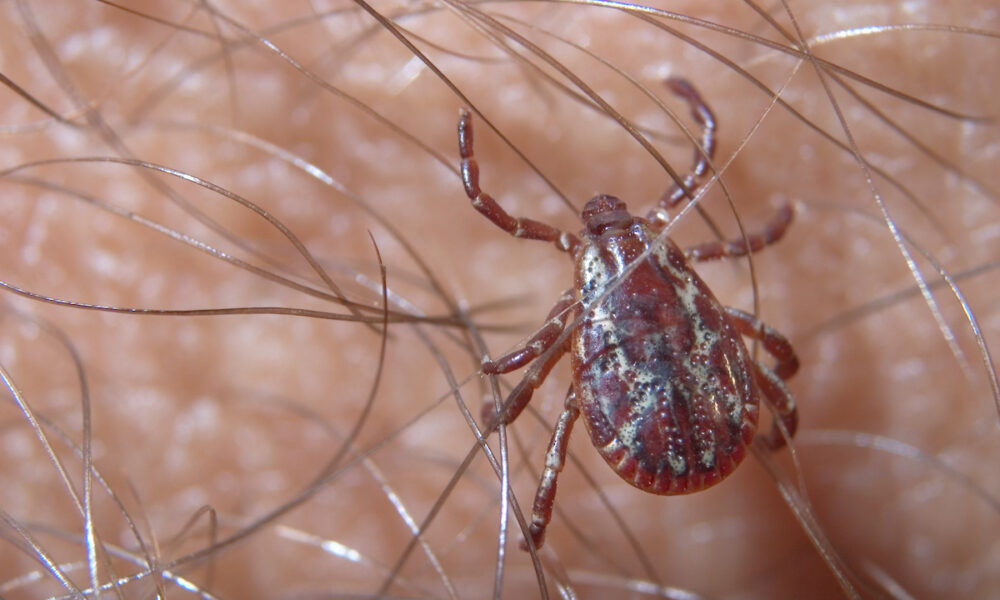
The American Dog Tick (Dermacentor variabilis) can be found across the continent on dogs, coyotes, bears and any other warm-bodied host that happens to walk by.
No Lyme Disease from this Tick
Some ticks are notorious for carrying the bacterium that causes Lyme Disease in humans. The good news is that there is no Lyme Disease from the American Dog Tick. It is not entirely harmless though because the American Dog Tick can carry Tularemia and Rocky Mountain Spotted Fever, two serious diseases that can adversely affect humans. Both list a high fever as a symptom, but individuals may vary in a variety of other symptoms connected to these illnesses. Bite wounds associated with Tularemia may form a skin ulcer (gaping wound). Both diseases can be successfully treated with antibiotics when diagnosed early, so it is essential to contact a physician immediately if bitten.
Eight Legs and No Wings
Ticks are 8-legged arachnids though they are not spiders. These ticks do not have wings, and they cannot fly. They are adept at attaching onto fur, hair, clothes, and fur that wisps past them within their reach.
Wood Tick
This tick is also known as a Wood Tick. Your dog or any other animal can get this tick from playing in the woods. Once the tick moves toward the skin, it then crawls to warmer parts of the body like armpits and inner thighs. There, it bites into the flesh while using a numbing agent in its saliva that renders the puncture imperceptible. It is then able to suck the blood from its host unhindered until it is fully engorged and more than double its original size.
Life Stages
The American Dog Tick has several life stages where the tick’s physical appearance slightly changes. The coloration changes from the nymph stage to adulthood and is different between genders. One might mistake them all for different species. Their wrinkly bodies can inflate like a balloon after a blood meal.
Taxonomic Hierarchy
Here is the hierarchy of the American Dog Tick:
Kingdom: Animalia
Phylum: Arthropoda
Class: Insecta
Order: Ixodida
Family: Ixodidae
Genus: Dermacentor
Species: variabilis
Identifying Information
Scientific Name: Dermacentor variabilis
Other Name(s): Wood Tick
Category: Mite or Tick
Size (Adult; Length): 2mm to 5mm (0.08in to 0.20in)
Colors: ivory, brown, red, black
Descriptors: tick, blood, round, slow, harmful, biting
Ticks and Hosts
Once a host is found, a mature tick feeds until it swells to ten times its original size. Males can stay on the host for up to three years, engorging, mating, and repeating the cycle. Females engorge, fall off, lay eggs, and die.
Symptoms
The symptoms of an American dog tick bite are:
- Itching
- Fever
- tick paralysis
Watch out for a rash that appears near the tick bite, as this is the primary symptom of tularemia and Rocky Mountain spotted fever.
Typically the symptoms of a tick-borne disease will occur within a few days to a few weeks after a tick bite. Make sure you see your doctor immediately after you receive a tick bite, even if you don’t have symptoms.
Contact Us
Choose Proactive Pest Control for professional, comprehensive, guaranteed pest, and lawn management. The pros at Proactive will work diligently to gain your trust, confidence, and your total satisfaction. CALL US TODAY at 770-800-PEST to schedule a free, no-obligation inspection and evaluation for your home or business. Or, contact us for a FREE consultation. Let us show you why Proactive Pest Control is northeast Georgia’s first choice for pest, termite, and lawn services.